LA-ICP-MS Analyses of Sulfides from Gold-Bearing Zones at the Perron Deposit, Abitibi Belt, Canada: Implications for Gold Remobilization through Metamorphism from Volcanogenic Mineralizations to Orogenic Quartz–Carbonate Veins
Abstract
:1. Introduction
2. Regional and Local Geology
3. Gold-Bearing Zones
3.1. Orogenic Gold Mineralization
3.1.1. High-Grade Zone
3.1.2. Grey Cat Zone
3.1.3. Gratien Zone
3.1.4. E2 Gold Zone
3.1.5. N110 Zone
3.2. Primary Volcanogenic-Related Mineralization
3.2.1. Central Polymetallic Zone
3.2.2. Donna Gold–Copper Zone
3.2.3. QF Zone
3.3. Hybrid-Style Mineralization
3.3.1. Team Zone
3.3.2. Upper High-Grade Zone
3.3.3. 210 Zone
3.3.4. Denise Zone
3.3.5. Eastern Denise Zone
4. Material and Methods
5. Results
5.1. Gold Habit and Sulfide Textures
5.2. Pyrite Trace Element Composition
5.3. Sphalerite Trace Element Composition
5.4. Pyrrhotite Trace Element Composition
5.5. Chalcopyrite Trace Element Composition
5.6. Origins of the Various Gold-Bearing Zones
5.7. Comparison of Pyrite and Pyrrhotite
5.8. Comparison of Pyrite with Chalcopyrite and Sphalerite
5.9. Pyrite Signature and Visible Gold
6. Discussion
6.1. Validity of the Classification of Gold-Bearing Zones
6.2. Source for the Gold in Orogenic Gold Mineralization
6.3. Why the HGZ Is So Rich in Gold
6.4. Why Is There an Exceptional Gold Endowment in the Eastern Gold Zone?
7. Conclusions
Supplementary Materials
Author Contributions
Funding
Data Availability Statement
Acknowledgments
Conflicts of Interest
References
- Dubé, B.; Mercier-Langevin, P. Gold deposits of the Archean Abitibi greenstone Belt, Canada. In Geology of the World’s Major Gold Deposits and provinces. Special Publications of the Society of Economic Geologists; Society of Economic Geologists: Littleton, CO, USA, 2020; Volume 23, pp. 669–708. [Google Scholar]
- Gaboury, D.; Pearson, V. Rhyolite Geochemical Signatures and Association with Volcanogenic Massive Sulfide Deposits: Examples from the Abitibi Belt, Canada. Econ. Geol. 2008, 103, 1531–1562. [Google Scholar] [CrossRef]
- Mathieu, L. Intrusion-associated gold systems and multistage metallogenic processes in the Neoarchean Abitibi Greenstone Belt. Minerals 2021, 11, 261. [Google Scholar] [CrossRef]
- Burrows, D.R.; Spooner, E.T.; Wood, P.C.; Jemielita, R.A. Structural controls on formation of the Hollinger-McIntyre Au quartz vein system in the Hollinger shear zone, Timmins, southern Abitibi greenstone belt, Ontario. Econ. Geol. 1993, 88, 1643–1663. [Google Scholar] [CrossRef]
- Helt, K.M.; Williams-Jones, A.E.; Clark, J.R.; Wing, B.A.; Wares, R.P. Constraints on the genesis of the Archean oxidized, intrusion-related Canadian Malartic gold deposit, Quebec, Canada. Econ. Geol. 2014, 109, 713–735. [Google Scholar] [CrossRef]
- Mercier-Langevin, P.; Dubé, B.; Hannington, M.D.; Davis, D.W.; Lafrance, B.; Gosselin, G. The LaRonde Penna Au-rich volcanogenic massive sulfide deposit, Abitibi greenstone belt, Quebec: Part I. Geology and geochronology. Econ. Geol. 2007, 102, 585–609. [Google Scholar] [CrossRef]
- Ayer, J.A.; Chartrand, J.E. Geological Compilation of the Abitibi Greenstone Belt: Ontario Geological Survey Miscellaneous Release Data 282; Ontario Geological Survey: Toronto, ON, Canada, 2011; 1 map, scale 1:250,000. [Google Scholar]
- Gaboury, D.; Genna, D.; Trottier, J.; Bouchard, M.; Augustin, J.; Malcolm, K. The Perron gold deposit, Archean Abitibi belt, Canada: Exceptionally high-grade mineralization related to higher gold-carrying capacity of hydrocarbon-rich fluids. Minerals 2021, 11, 1066. [Google Scholar] [CrossRef]
- Lafrance, B. Reconstruction d’un Environnement de Sulfures Massifs Volcanogènes Déformés: Exemple Archéen de Normétal, Abitibi. PhD Thesis, Université du Québec à Chicoutimi, Chicoutimi, QC, Canada, 2003; 362p. [Google Scholar]
- Yang, X.-M.; Lentz, D.R.; Sylvester, P.J. Gold contents of sulfide minerals in granitoids from southwestern New Brunswick, Canada. Miner. Depos. 2006, 41, 369–386. [Google Scholar] [CrossRef]
- Large, R.R.; Bull, S.W.; Maslennikov, V.V. A carbonaceous sedimentary source-rock model for Carlin-type and orogenic gold deposits. Econ. Geol. 2011, 106, 331–358. [Google Scholar] [CrossRef]
- Large, R.R.; Halpin, J.A.; Danyushevsky, L.V.; Maslennikov, V.V.; Bull, S.W.; Long, J.A.; Gregory, D.D.; Lounejeva, E.; Lyons, T.W.; Sack, P.J.; et al. Trace element content of sedimentary pyrite as a new proxy for deeptime ocean-atmosphere evolution. Earth Planet. Sci. Lett. 2014, 389, 209–220. [Google Scholar] [CrossRef]
- Cook, N.J.; Ciobanu, C.L.; Meria, D.; Silcock, D.; Wade, B. Arsenopyrite-pyrite association in an orogenic gold ore: Tracing mineralization history from textures and trace elements. Econ. Geol. 2013, 108, 1273–1283. [Google Scholar] [CrossRef]
- Genna, D.; Gaboury, D. Deciphering the Hydrothermal Evolution of a VMS System by LA-ICP-MS Using Trace Elements in Pyrite: An Example from the Bracemac-McLeod Deposits, Abitibi, Canada, and Implications for Exploration. Econ. Geol. 2015, 110, 2087–2108. [Google Scholar] [CrossRef]
- Steadman, J.A.; Large, R.R.; Olin, P.H.; Danyushevsky, L.V.; Meffre, S.; Huston, D.; Fabris, A.; Lisitsin, V.; Wells, T. Pyrite trace element behavior in magmatic-hydrothermal environments: An LA-ICPMS imaging study. Ore Geol. Rev. 2021, 128, 103878. [Google Scholar] [CrossRef]
- Belousov, I.; Large, R.R.; Meffre, S.; Danyushevsky, L.V.; Steadman, J.; Beardsmore, T. Pyrite compositions from VHMS and orogenic Au deposits in the Yilgarn Craton, Western Australia: Implications for gold and copper exploration. Ore Geol. Rev. 2016, 79, 474–499. [Google Scholar] [CrossRef]
- Keith, M.; Smith, D.J.; Jenkin, G.R.T.; Holwell, D.A.; Dye, M.D. A review of Te and Se systematics in hydrothermal pyrite from precious metal deposits: Insights into ore-forming processes. Ore Geol. Rev. 2018, 96, 269–282. [Google Scholar] [CrossRef]
- Augustin, J.; Gaboury, D. Multi-stage and multi-sourced fluid and gold in the formation of orogenic gold deposits in the world-class Mana district of Burkina Faso-Revealed by LA-ICP-MS analysis of pyrites and arsenopyrites. Ore Geol. Rev. 2019, 104, 495–521. [Google Scholar] [CrossRef]
- Gaboury, D.; Ore Sanchez, C. Electrochemical gold precipitation to explain extensive vertical and lateral mineralization in the world-class Poderosa-Pataz district, Peru. Terra Nova 2020, 32, 97–107. [Google Scholar] [CrossRef]
- Steadman, J.A.; Large, R.R. Synsedimentary, diagenetic, and metamorphic pyrite, pyrrhotite, and marcasite at the Homestake BIF-hosted gold deposit, south Dakota, USA: Insights on Au-As ore genesis from textural and LA-ICP-MS trace element studies. Econ. Geol. 2016, 111, 1731–1752. [Google Scholar] [CrossRef]
- Kang, J.; Gregory, D.D.; Gill, B.; Huang, S.; Lai, C.; Chang, Z.; Cui, H.; Belousov, I.; Xiao, S. Trace element evidence for diverse origins of superheavy pyrite in Neoproterozoic sedimentary strata. Geochim. Cosmochim. Acta 2024, 364, 1–9. [Google Scholar] [CrossRef]
- Card, K.D. A review of the Superior Province of the Canadian Shield, a product of Archean accretion. Precambrian Res. 1990, 48, 99–156. [Google Scholar] [CrossRef]
- Chown, E.H.; Daigneault, R.; Mueller, W. Tectonic evolution of the Northern Volcanic Zone, Abitibi belt, Quebec. Can. J. Earth Sci. 1992, 29, 2211–2225. [Google Scholar] [CrossRef]
- Monecke, T.; Mercier-Langevin, P.; Dubé, B.; Frieman, B. Geology of the Abitibi greenstone belt. In Archean Base and Precious Metal Deposits, Southern Abitibi Greenstone Belt, Canada, Reviews in Economic Geology; Monecke, T., Mercier-Langevin, P., Dubé, B., Eds.; Society of Economic Geologists: Littleton, CO, USA, 2017; Volume 19, pp. 7–49. [Google Scholar]
- Gaboury, D. Geochemical approaches in the discrimination of synvolcanic intrusions as a guide for volcanogenic base metal exploration: Example from the Abitibi belt, Canada. Appl. Earth Sci. 2006, 115, 71–79. [Google Scholar] [CrossRef]
- Mercier-Langevin, P.; Dubé, B.; Houlé, M.G.; Bécu, V.; Sappin, A.A.; Pilote, J.L.; Castonguay, S. Metallogeny of the Abitibi Greenstone Belt, Canada. In Metallic Resources 2: Geodynamic Framework and Remarkable Examples in the World; Wiley: New York, NY, USA, 2023; pp. 63–141. [Google Scholar]
- Mortensen, J.K. U-Pb gechronology of the eastern Abitibi Subprovince. Part 1: Chibougamau-Matagami-Joutel. Can. J. Earth Sci. 1993, 30, 11–28. [Google Scholar] [CrossRef]
- Barrett, T.J.; Ayer, J.A.; Ordóñez-Calderón, J.C.; Hamilton, M.A. Burntbush-Normétal volcanic belt, Abitibi greenstone belt, Ontario-Quebec: Geological Mapping and Compilation Project, Discover Abitibi Initiative. In Geological Mapping and Compilation of the Burntbush-Normétal Volcanic Belt, Abitibi Greenstone Belt, Ontario-Quebec, Miscellaneous Release—Data 299; Ontario Geological Survey: Sudbury, ON, Canada, 2013; 135p. [Google Scholar]
- Teasdale, N. Regional Study of Geochemical Alteration Associated with the Normétal Deposit Abitibi Greenstone Belt, Québec. Master’s Thesis, École Polytechnique, Montreal, QC, Canada, 1993; 160p. [Google Scholar]
- Lesher, C.M.; Goodwin, A.M.; Campbell, I.H.; Gorton, M.P. Trace-element geochemistry of ore-associated and barren, felsic metavolcanic rocks in the Superior Province, Canada. Can. J. Earth Sci. 1986, 23, 222–237. [Google Scholar] [CrossRef]
- Fayard, Q. Lithogeochemistry Phase II–New Advances, Perron Project; Part 1: New Classification and Implications for Our Understanding of Perron’s Metallogeny. Internal Report to Amex Exploration; Amex Exploration: Abitibi, QC, Canada, 2023; 17p. [Google Scholar]
- Zhang, Q.; Machado, N.; Ludden, J.N.; Moore, D. Geotectonic Constraints from U-Pb Ages for the Blake River Group, the KinojevisGroup and the Normetal Mine Area, Abitibi, Quebec. Program and Abstract; MAC/AMC: Edmonton, AB, Canada, 1993; p. A-114. [Google Scholar]
- Lafrance, B.; Mueller, W.U.; Daigneault, R.; Dupras, N. Evolution of a submerged composite arc volcano: Volcanology and geochemistry of the Normétal volcanic complex, Abitibi greenstone belt, Québec, Canada. Precambrian Res. 2000, 101, 277–311. [Google Scholar] [CrossRef]
- Frenzel, M.; Hirsch, T.; Gutzmer, J. Gallium, germanium, indium, and other trace and minor elements in sphalerite as a function of deposit type—A meta-analysis. Ore Geol. Rev. 2016, 76, 52–78. [Google Scholar] [CrossRef]
- Bralia, A.; Sabatini, G.; Troja, F.A. Revaluation of the Co/Ni ratio in pyrite as geochemical tool in ore genesis problems. Mineral. Depos. 1979, 14, 353–374. [Google Scholar] [CrossRef]
- Conn, C.D.; Spry, P.G.; Layton-Matthews, D.; Voinot, A.; Koenig, A. The effects of amphibolite facies metamorphism on the trace element composition of pyrite and pyrrhotite in the Cambrian Nairne Pyrite Member, Kanmantoo Group, South Australia. Ore Geol. Rev. 2019, 114, 103128. [Google Scholar] [CrossRef]
- Slack, J.F.; Van Baalen, M.R.; Reusch, D.N. Regional geochemical variations in a metamorphosed black shale: A reconnaissance study of the Silurian Smalls Falls Formation, Maine, USA. Atl. Geol. 2020, 56, 231–255. [Google Scholar] [CrossRef]
- Suhendra, R.; Takahashi, R.; Agangi, A.; Imai, A.; Sato, H.; Setiawan, N.I. Textural-compositional evolution of pyrite and metal remobilization during low-grade metamorphism of metapelite: Contribution to gold mineralization in the Luk Ulo Complex, Central Java, Indonesia. Ore Geol. Rev. 2014, 166, 105966. [Google Scholar] [CrossRef]
- Graham, U.M.; Ohmoto, H. Experimental study of formation mechanisms of hydrothermal pyrite. Geochim. Cosmochim. Acta 1994, 58, 2187–2202. [Google Scholar] [CrossRef]
- Tomkins, A.G. Windows of metamorphic sulfur liberation in the crust: Implications for gold deposit genesis. Geochim. Cosmochim. Acta. 2010, 74, 3246–3259. [Google Scholar] [CrossRef]
- Gaboury, D. Does gold in orogenic deposits come from pyrite in deeply buried carbon-rich sediments? Insight from volatiles in fluid inclusions. Geology 2013, 41, 1207–1210. [Google Scholar] [CrossRef]
- Gaboury, D. Parameters for the formation of orogenic gold deposits. Appl. Earth Sci. 2019, 128, 124–133. [Google Scholar] [CrossRef]
- Benedetto, R.D.; Bernardini, G.P.; Costagliola, P.; Plant, D.; Vaughan, D.J. Compositional zoning in sphalerite crystals. Am. Mineral. 2005, 90, 1384–1392. [Google Scholar] [CrossRef]
- Goldfarb, R.J.; Pitcairn, I. Orogenic gold: Is a genetic association with magmatism realistic? Miner. Depos. 2023, 58, 5–35. [Google Scholar] [CrossRef]
- Gaboury, D. The neglected involvement of organic matter in forming large and rich hydrothermal orogenic gold deposits. Geosciences 2021, 11, 344. [Google Scholar] [CrossRef]
- Large, R.R.; Maslennikov, V.V.; Robert, F.; Danyushevsky, L.V.; Chang, Z. Multistage sedimentary and metamorphic origin of pyrite and gold in the giant Sukhoi Log deposit, Lena gold province, Russia. Econ. Geol. 2007, 102, 1233–1267. [Google Scholar] [CrossRef]
- Thomas, H.V.; Large, R.R.; Bull, S.W.; Maslennikov, V.; Berry, R.F.; Fraser, R.; Froud, S.; Moye, R. Pyrite and pyrrhotite textures and composition in sediments, laminated quartz veins, and reefs at Bendigo gold mine, Australia: Insights for ore genesis. Econ. Geol. 2011, 106, 1–31. [Google Scholar] [CrossRef]
- Pasava, J.; Frimmel, H.; Vymazalová, A.; Dobes, P.; Jukov, A.V.; Koneev, R.I. A two-stage evolution model for the Amantaytau orogenic-type gold deposit in Uzbekistan. Miner. Depos. 2013, 48, 825–840. [Google Scholar] [CrossRef]
- Large, R.; Thomas, H.; Craw, D.; Henne, A.; Henderson, S. Diagenetic pyrite as a source for metals in orogenic gold deposits, Otago Schist, New Zealand. N. Z. J. Geol. Geophys. 2012, 55, 137–149. [Google Scholar] [CrossRef]
- Gaboury, D.; Mackezie, D.; Craw, D. Fluid volatile composition associated with orogenic gold mineralization, Otago Schist, New Zealand: Implications of H2 and C2H6 for fluid evolution and gold source. Ore Geol. Rev. 2021, 133, 104086. [Google Scholar] [CrossRef]
- Gaboury, D.; Nabil, H.; Ennaciri, A.; Maacha, L. Structural setting and fluid composition of gold mineralization along the central segment of the Keraf suture, Neoproterozoic Nubian Shield, Sudan: Implications for the source of gold. Int. Geol. Rev. 2022, 64, 45–71. [Google Scholar] [CrossRef]
- Pitcairn, I.K.; Leventis, N.; Beaudoin, G.; Faure, S.; Guilmette, C.; Dubé, B. A metasedimentary source of gold in Archean orogenic gold deposits. Geology 2021, 49, 862–866. [Google Scholar] [CrossRef]
- Goldfarb, R.J.; Groves, D.I. Orogenic gold: Common vs evolving fluid and metal sources through time. Lithos 2015, 223, 2–26. [Google Scholar] [CrossRef]
- Wyman, D.A.; Cassidy, K.F.; Hollings, P. Orogenic gold and the mineral systems approach: Resolving fact, fiction and fantasy. Ore Geol. Rev. 2016, 78, 322–335. [Google Scholar] [CrossRef]
- Groves, D.I.; Santosh, M.; Deng, J.; Wang, Q.; Yang, L.; Zhang, L. A holistic model for the origin of orogenic gold deposits and its implications for exploration. Miner. Depos. 2020, 55, 275–292. [Google Scholar] [CrossRef]
- Zenk, M.; Schulz, B. Zoned Ca-amphiboles and related P-T evolution in metabasites from the classical Barrovian metamorphic zones in Scotland. Miner. Mag. 2004, 68, 769–786. [Google Scholar] [CrossRef]
- Finch, E.G.; Tomkins, A.G. Pyrite-Pyrrhotite Stability in a Metamorphic Aureole: Implications for Orogenic Gold Genesis. Econ. Geol. 2017, 112, 661–674. [Google Scholar] [CrossRef]
- Phillips, G.N.; Powell, R. Formation of gold deposits: A metamorphic devolatilization model. J. Metam. Geol. 2010, 28, 689–718. [Google Scholar] [CrossRef]
- Hutchinson, R.W. A multi-stage, multi-process genetic hypothesis for greenstone-hosted gold lodes. Ore Geol. Rev. 1993, 8, 349–382. [Google Scholar] [CrossRef]
- Powell, W.G.; Carmichael, D.M.; Hodgson, C.J. Conditions and timing of metamorphism in the southern Abitibi greenstone belt, Quebec. Can. J. Earth Sci. 1995, 32, 787–805. [Google Scholar] [CrossRef]
- Faure, S. Relations Entre les Minéralisations Aurifères et les Isogrades Métamorphiques en Abitibi. Rapport Projet CONSOREM 2013-03. 2015. 52p. Available online: https://consorem2.uqac.ca/production_scientifique/2013_03/2013-03_Final.pdf (accessed on 23 March 2024).
- Cockerton, A.B.; Tomkins, A.G. Insights into the liquid bismuth collector model through analysis of the Bi-Au Stormont skarn prospect, northwest Tasmania. Econ. Geol. 2012, 107, 667–682. [Google Scholar] [CrossRef]
- Feng, H.; Shen, P.; Zhu, R.; Tomkins, A.G.; Brugger, J.; Ma, G.; Li, C.; Wu, Y. Bi/Te control on gold mineralizing processes in the North China Craton: Insights from the Wulong gold deposit. Miner. Depos. 2023, 58, 263–286. [Google Scholar] [CrossRef]
- Douglas, N.; Mavrogenes, J.; Hack, A.; England, R. The liquid bismuth collector model: An alternative gold deposition mechanism. In Understanding Planet Earth; Searching for a Sustainable Future; on the Starting Blocks of the Third Millennium: Australian Geological Convention, 15th, Sydney; Skilbeck, C.G., Hubble, T.C.T., Eds.; Geological Society of Australia: Sydney, Australia, 2000; 135p. [Google Scholar]
- Tooth, B.; Brugger, J.; Ciobanu, C.; Liu, W. Modeling of gold scavenging by bismuth melts coexisting with hydrothermal fluids. Geology 2008, 36, 815–818. [Google Scholar] [CrossRef]
- Frost, B.R.; Mavrogenes, J.A.; Tomkins, A.G. Partial melting of sulfide deposits during medium- and high-grade metamorphism. Can. Mineral. 2002, 40, 1–18. [Google Scholar] [CrossRef]
- Goldfarb, R.J.; Baker, T.; Dube, B.; Groves, D.I.; Hart, C.J.; Gosselin, P. Distribution, character and genesis of gold deposits in metamorphic terranes. In Economic Geology: One Hundredth Anniversary Volume; Society of Economic Geologists: Littleton, CO, USA, 2005; pp. 407–450. [Google Scholar]
- Tomkins, A.G.; Weinberg, R.F.; McFarlane, C.R. Preferential magma extraction from K-and metal-enriched source regions in the crust. Miner. Depos. 2009, 44, 171–181. [Google Scholar] [CrossRef]
- Wehrle, E.A.; Samson, I.M.; Montreuil, J.F.; Kontak, D.J. Au-Bi-Te(-Cu) Mineralization in the Wawa Gold Corridor (Ontario, Canada): Implications for the Role of Bi-Rich Polymetallic Melts in Orogenic Au Systems. Minerals 2023, 13, 1119. [Google Scholar] [CrossRef]
- Herzog, M.; LaFlamme, C.; Beaudoin, G.; Barré, G.; Martin, L.; Savard, D. Fluid-rock sulfidation reactions control Au-Ag-Te-Bi precipitation in the Val-d’Or orogenic gold vein field (Abitibi subprovince, Canada). Miner. Depos. 2024, 59, 1039–1064. [Google Scholar] [CrossRef]
- Martin, A.N.; Stüeken, E.E.; Michaud, J.S.; Münker, C.; Weyer, S.; van Hees, E.H.P.; Gehringer, M.M. Mechanisms of nitrogen isotope fractionation at an ancient black smoker in the 2.7 Ga Abitibi greenstone belt, Canada. Geology 2024, 52, 181–186. [Google Scholar] [CrossRef]
- Dubé, B.; Gosselin, P.; Mercier-Langevin, P.; Hannington, M.; Galley, A. Gold-rich volcanogenic massive sulphide deposits. Geol. Assoc. Can. Miner. Depos. Div. 2007, 75–94. [Google Scholar]
- Yang, K.; Scott, S.D. Magmatic fluids as a source of metals in seafloor hydrothermal systems. In Geophysical Monograph Series; American Geophysical Union: Washington, DC, USA, 2006; Volume 166, pp. 163–184. [Google Scholar]
- Sillitoe, R.H. Gold-rich porphyry deposits: Descriptive and genetic models and their role in exploration and discovery. Soc. Econ. Geol. Rev. 2000, 13, 315–345. [Google Scholar]
- Genna, D.; Gaboury, D.; Moore, L.; Mueller, W.U. Use of micro-XRF chemical analysis for mapping volcanogenic massive sulfide related hydrothermal alteration: Application to the subaqueous felsic dome-flow complex of the Cap d’Ours section, Glenwood rhyolite, Rouyn-Noranda, Québec, Canada. J. Geochem. Explor. 2011, 108, 131–142. [Google Scholar] [CrossRef]
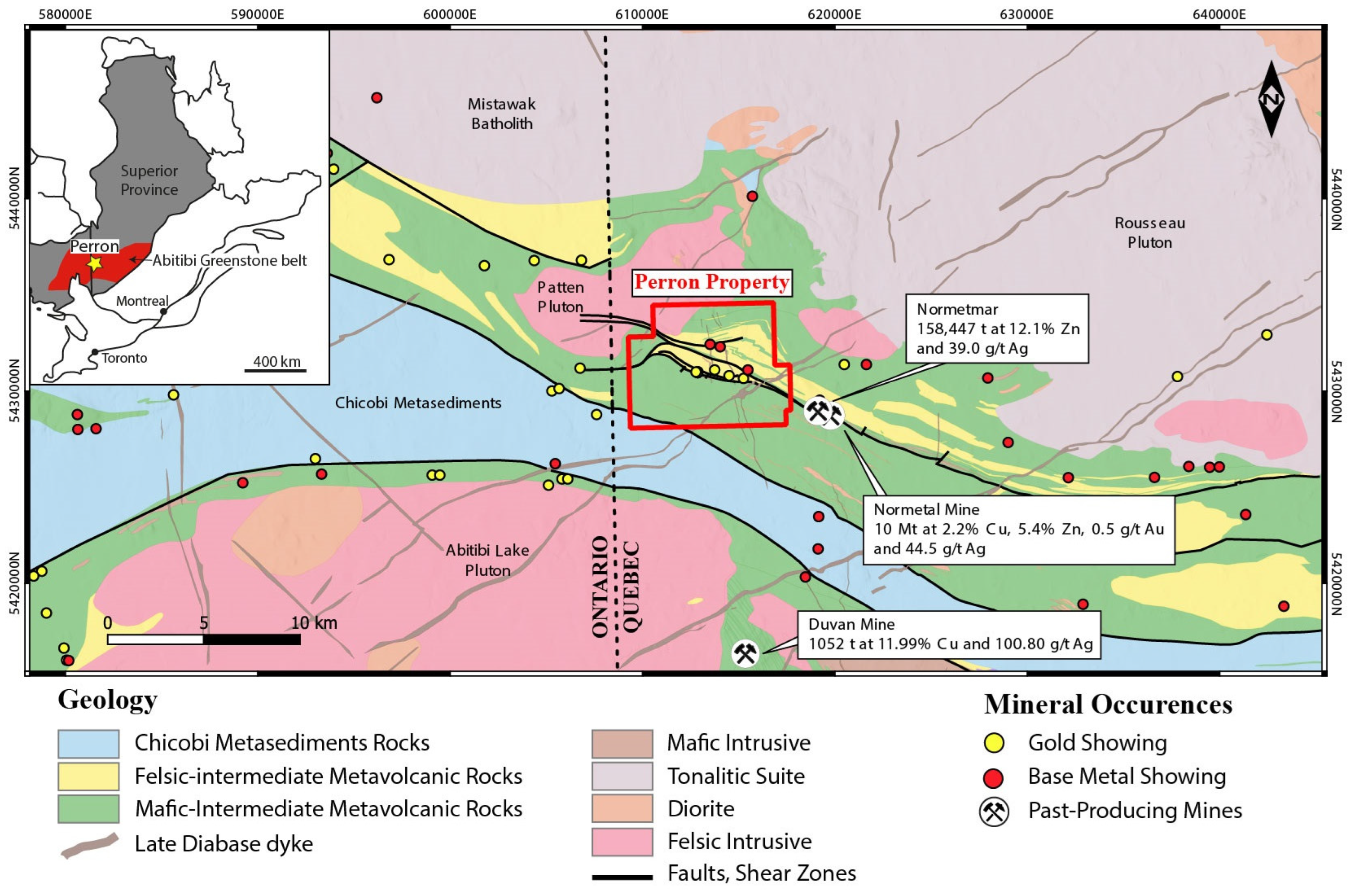
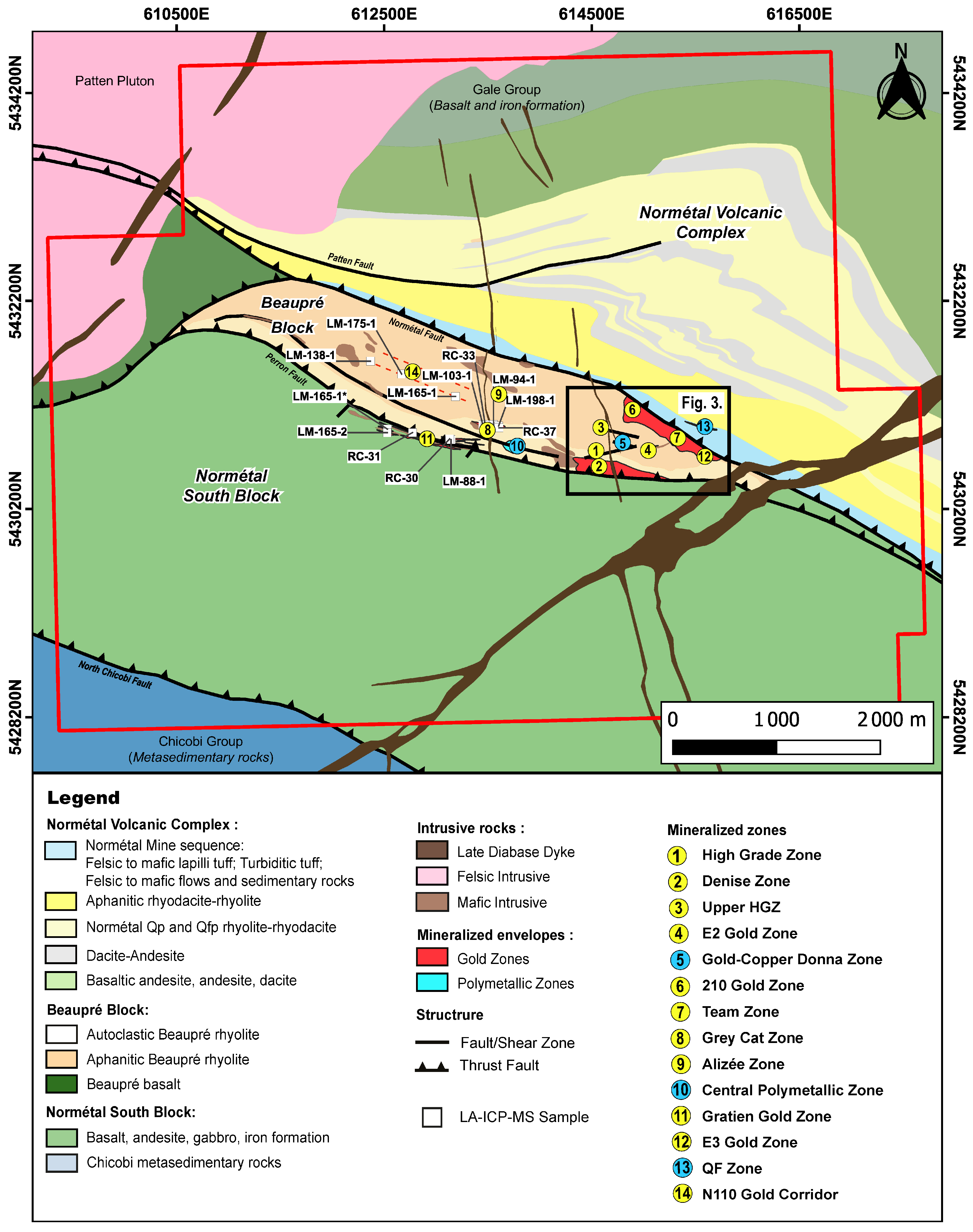

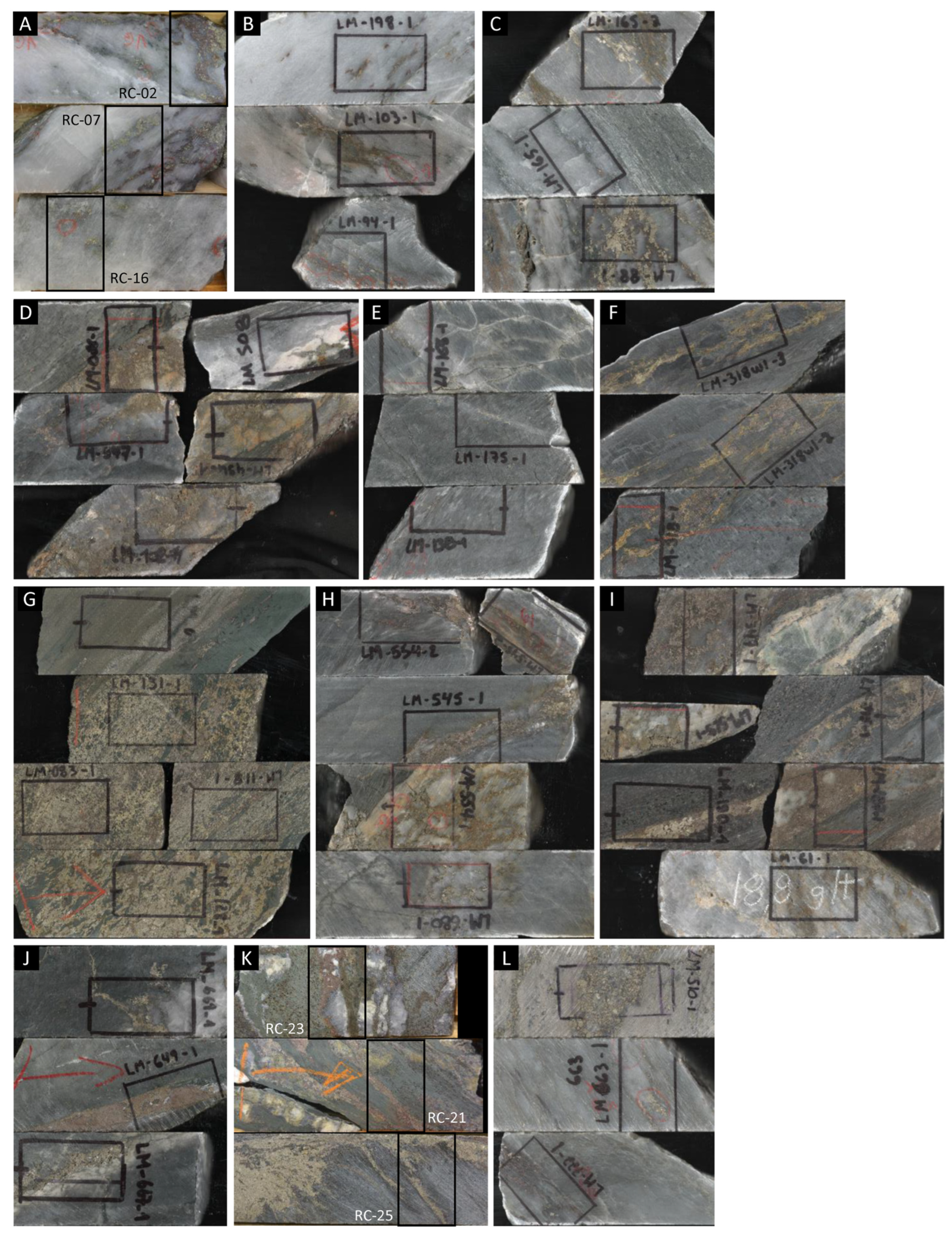
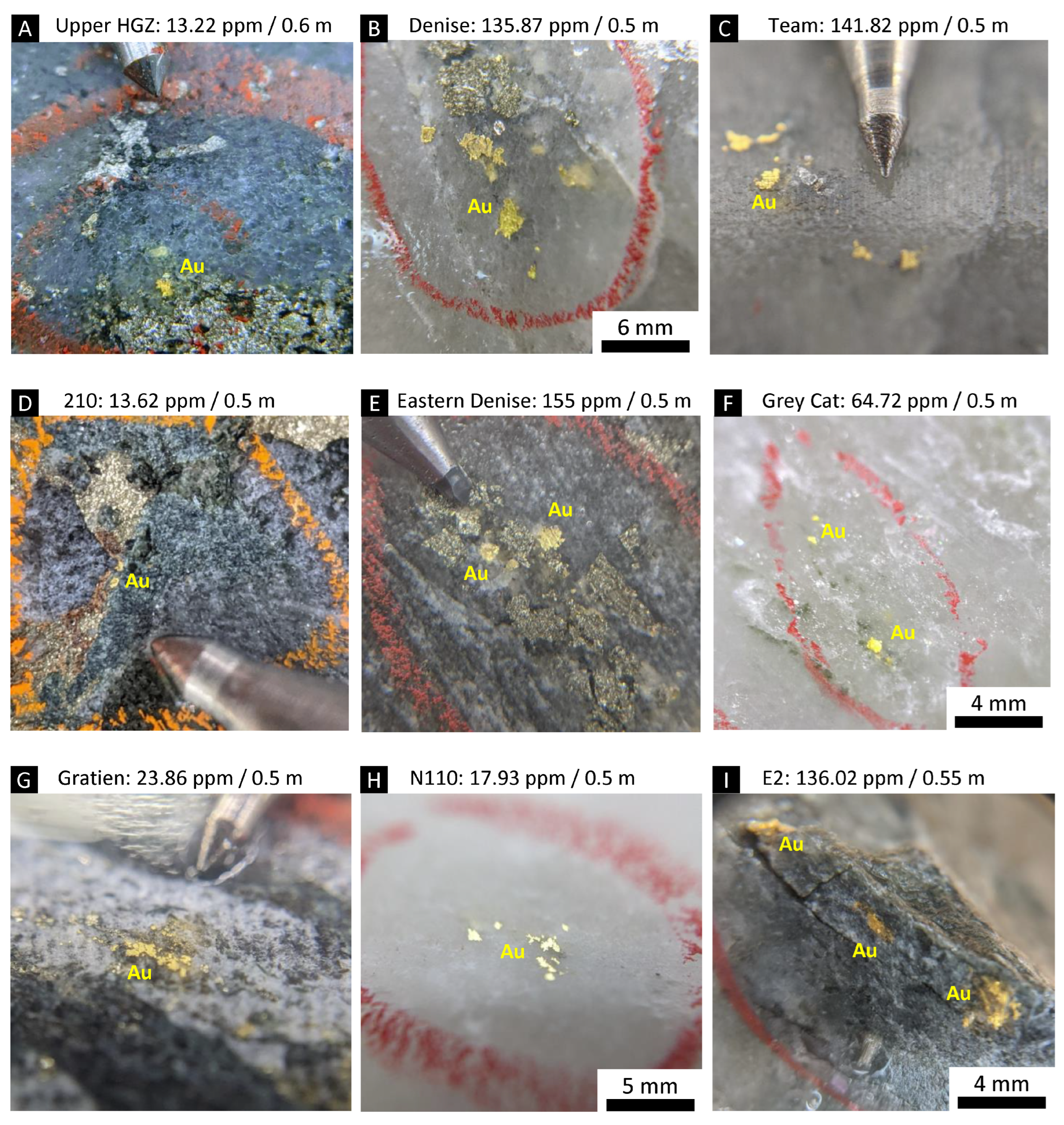
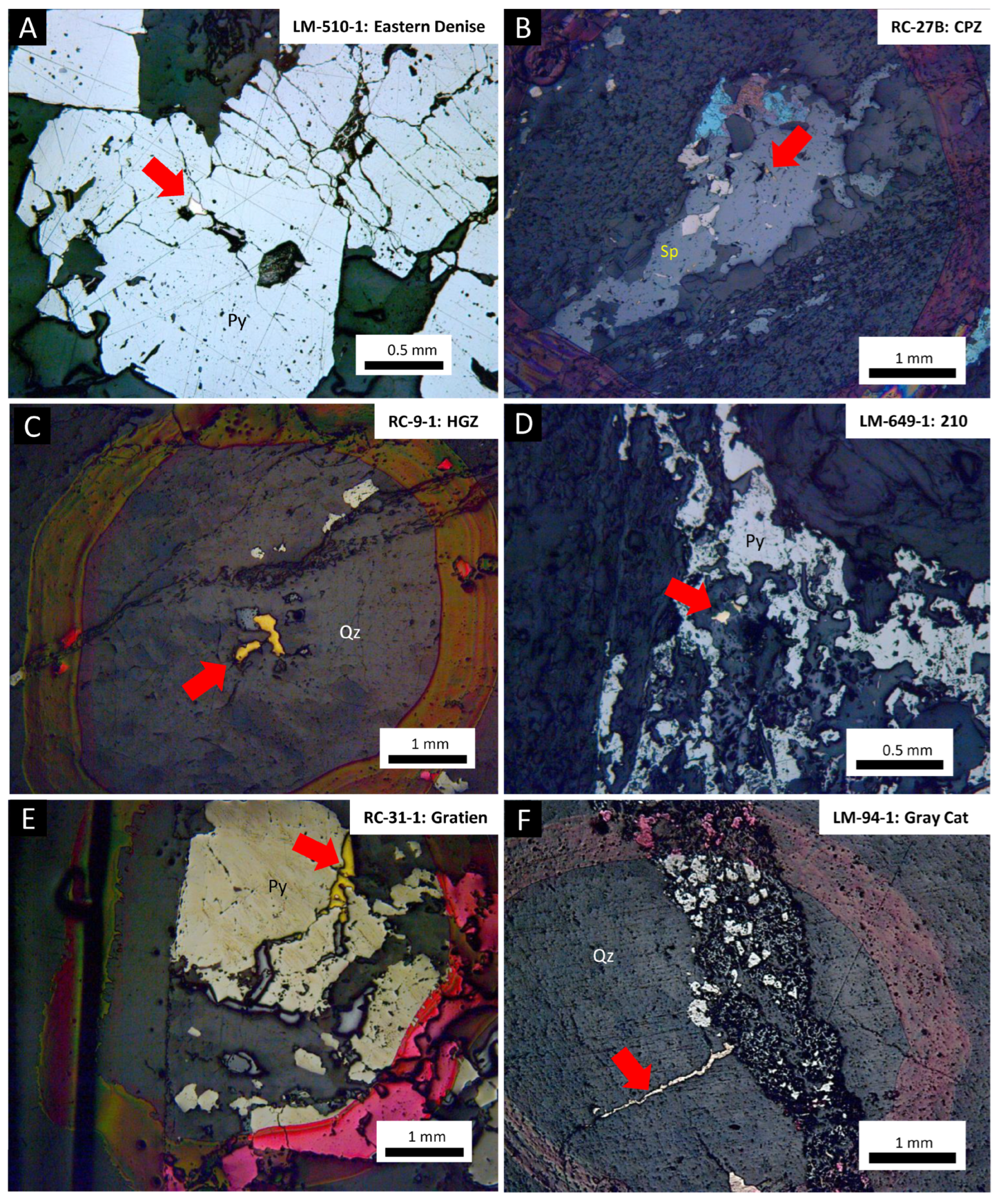
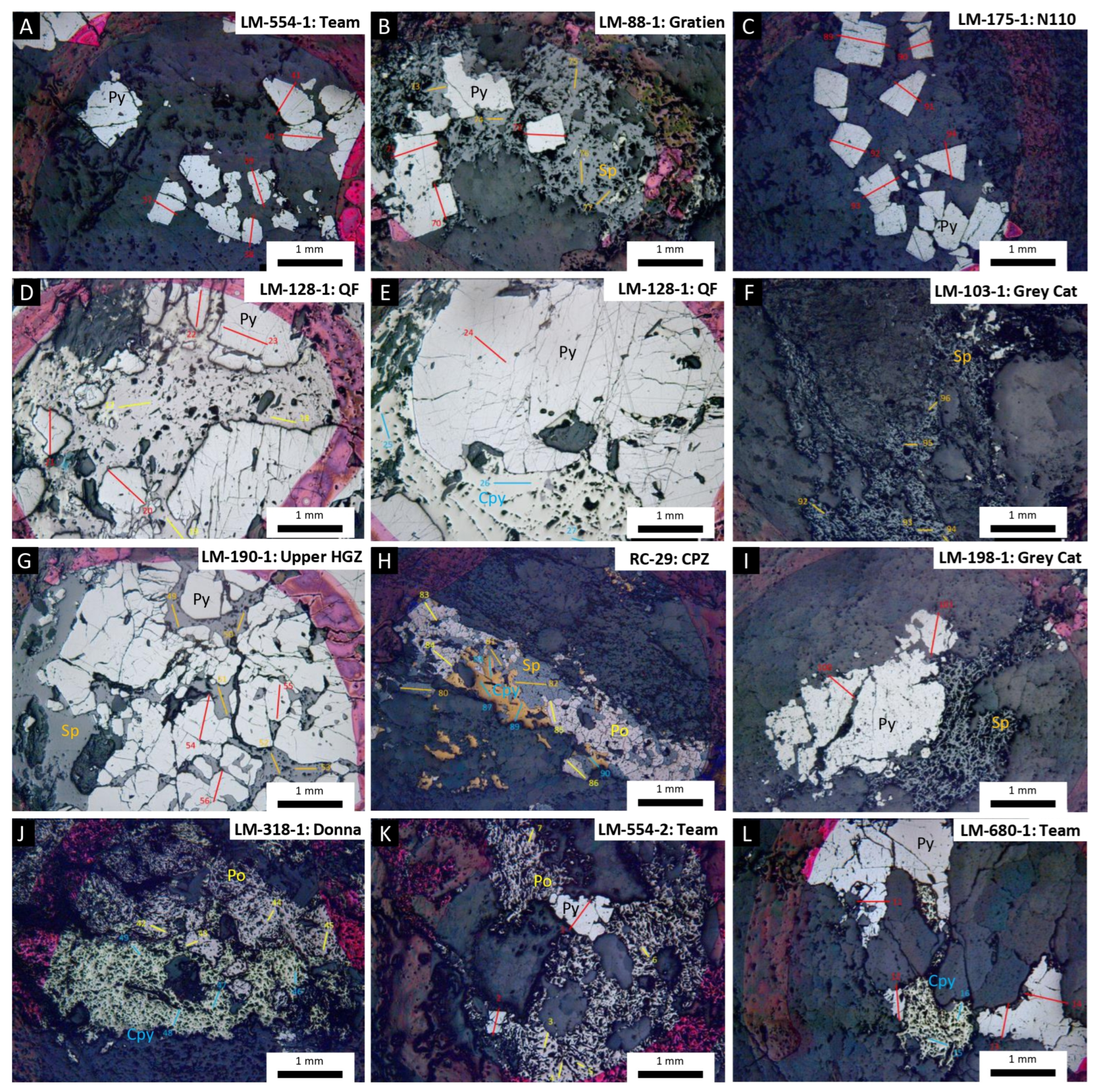


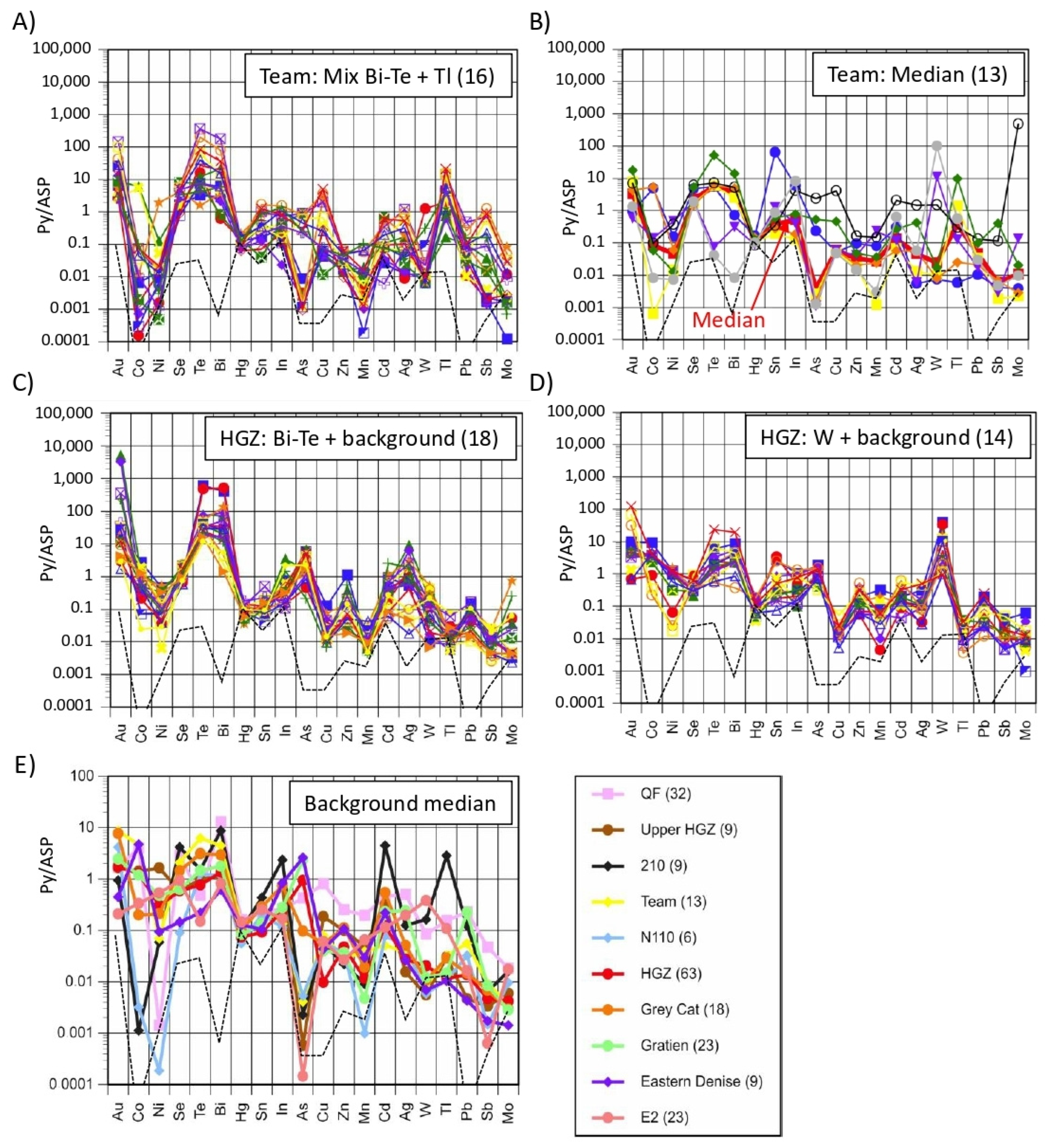
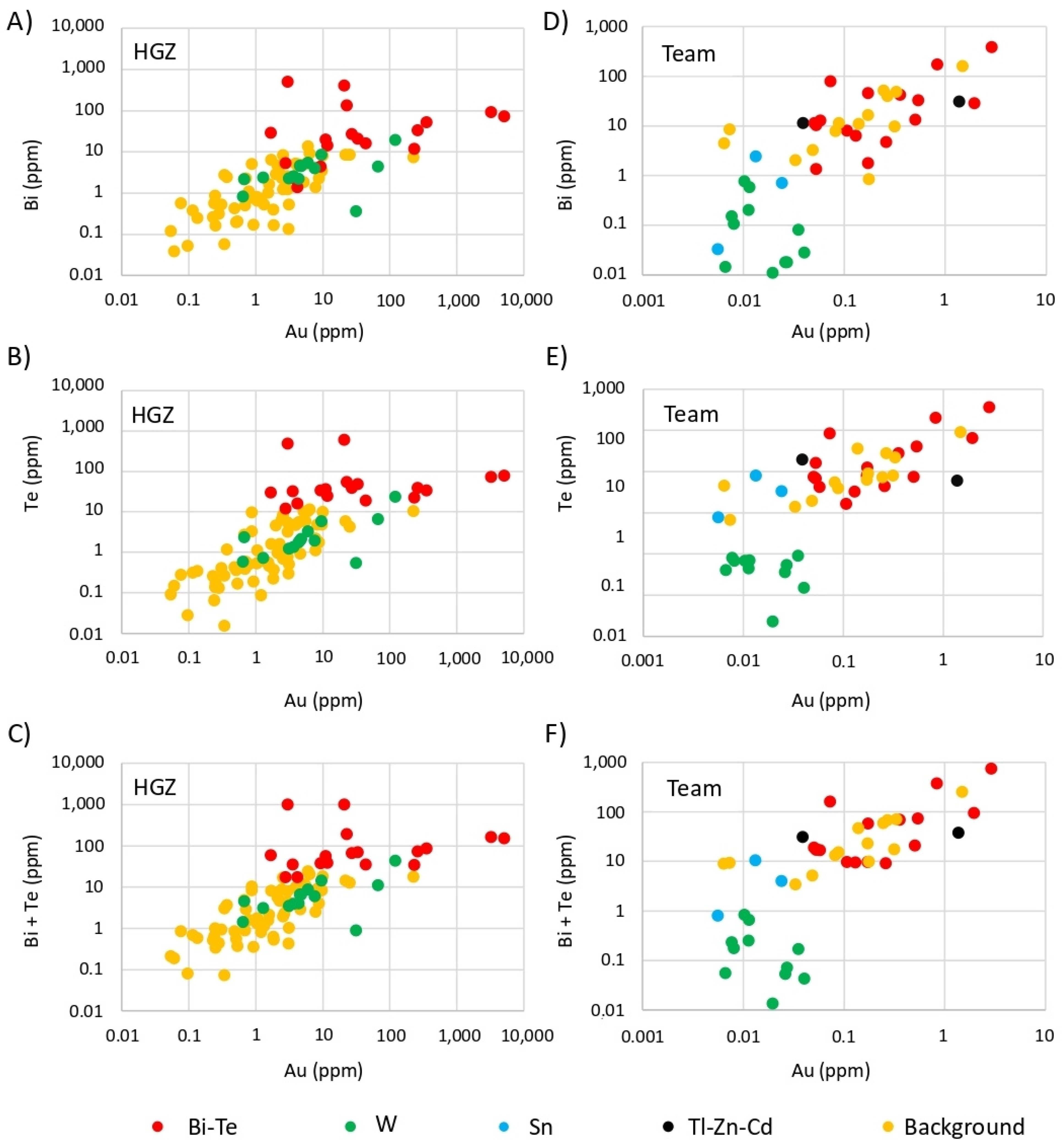

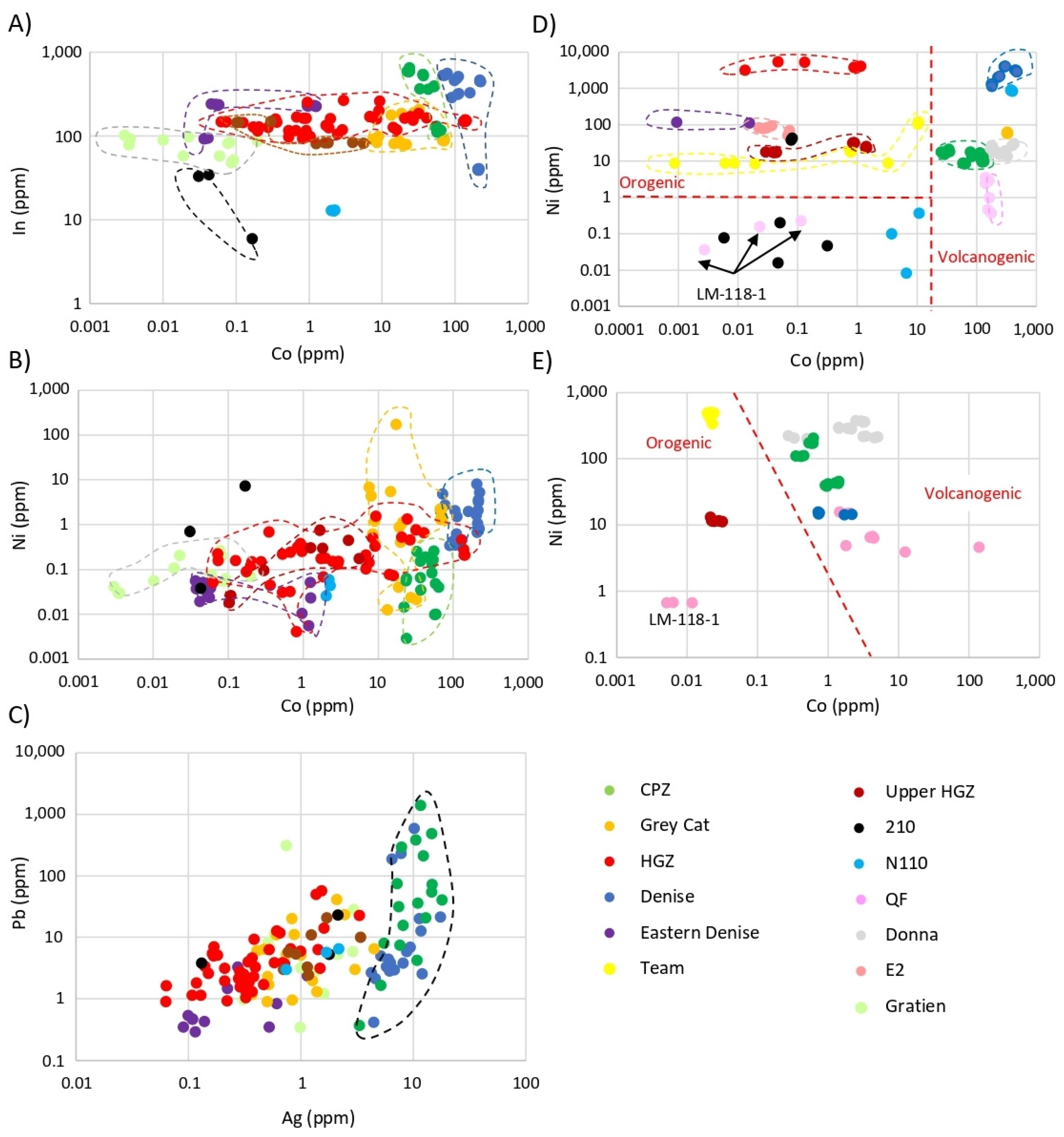
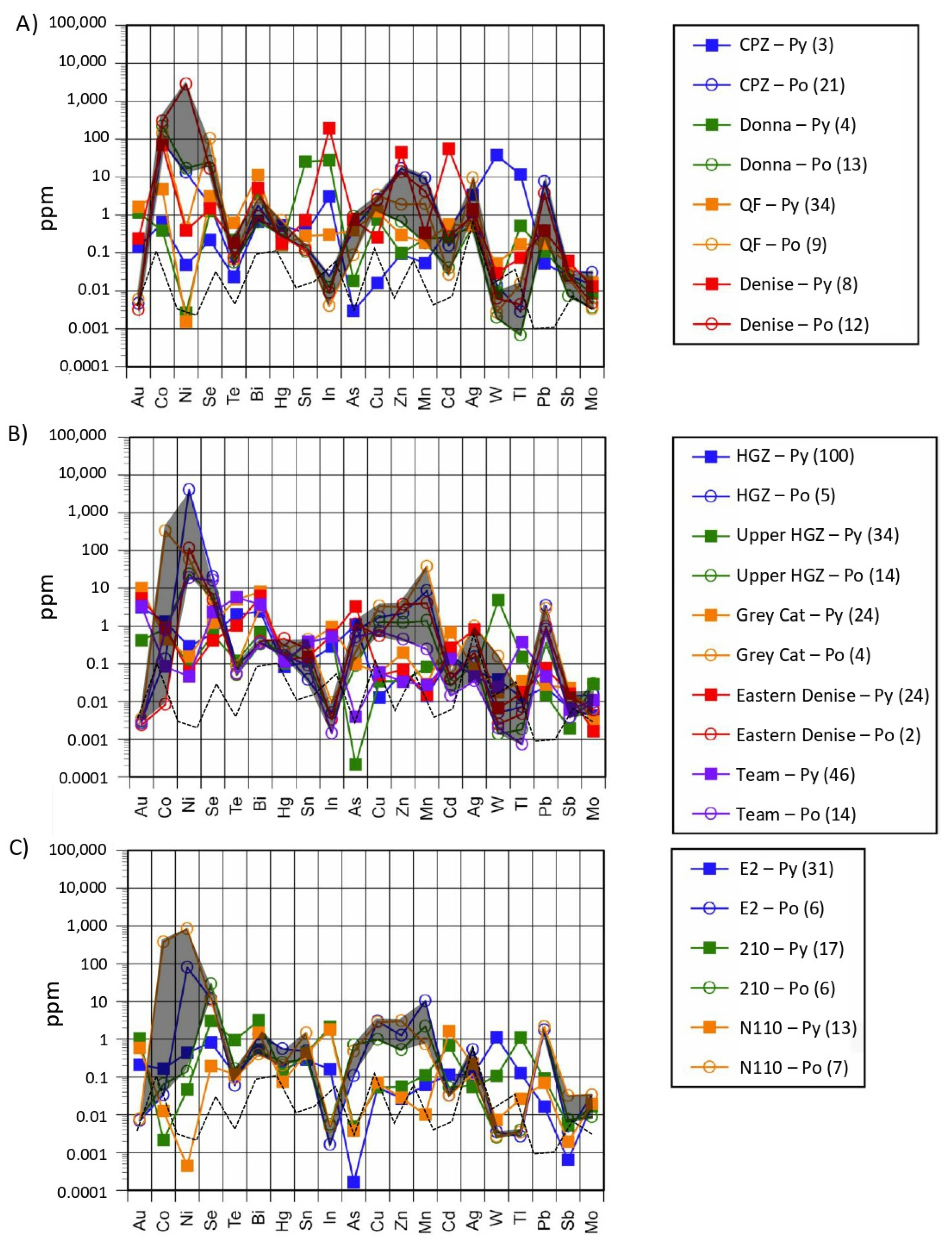
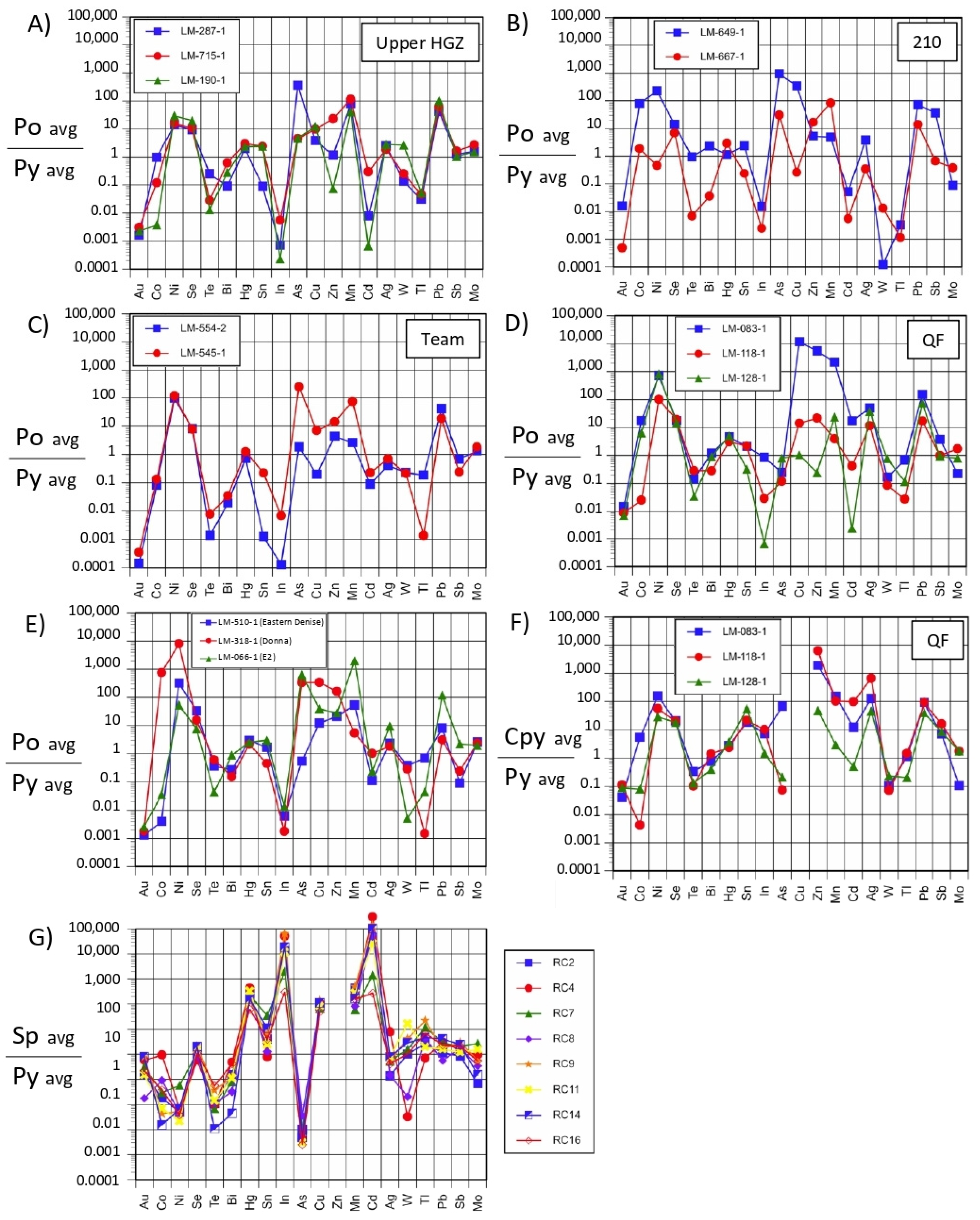
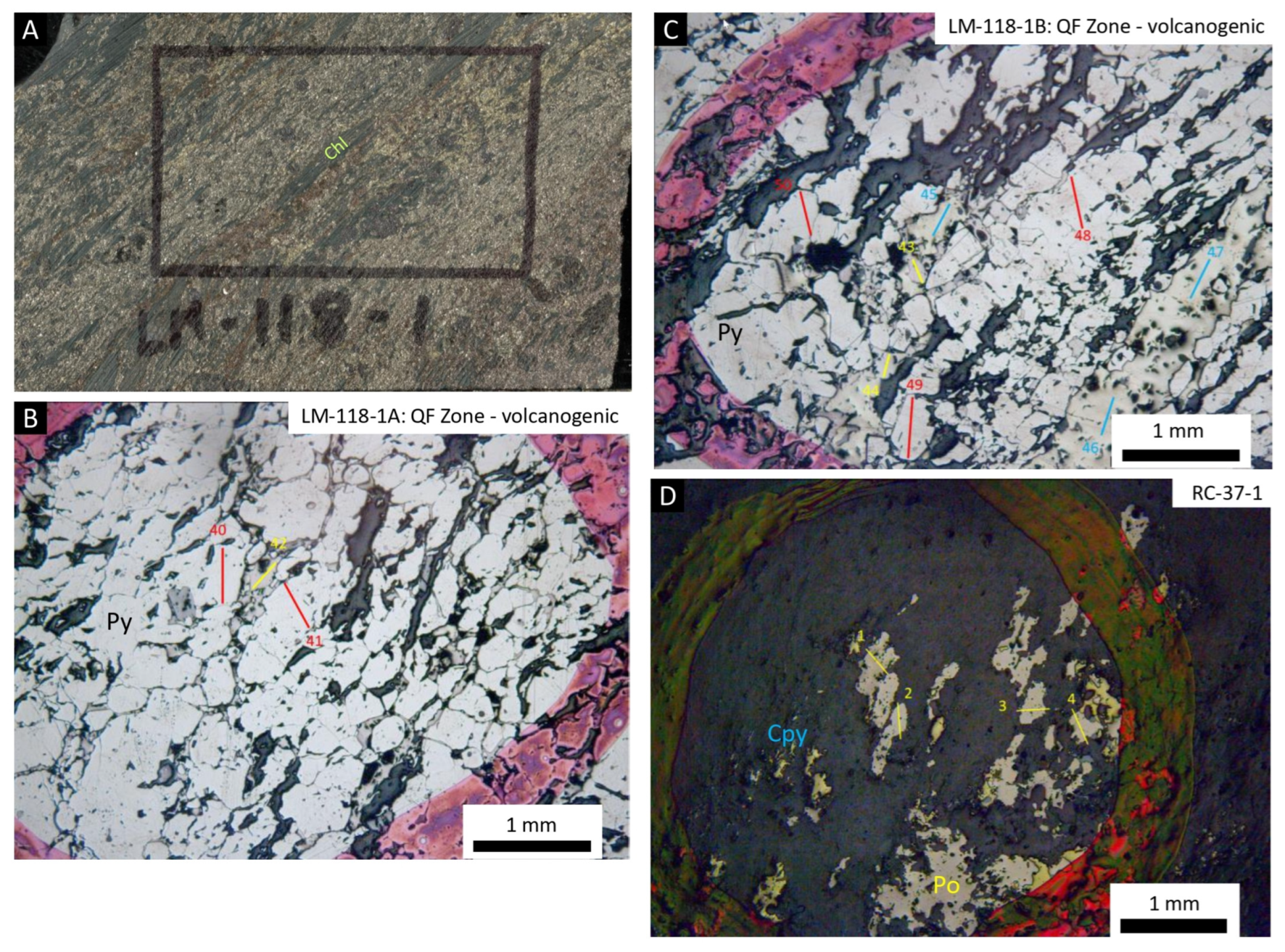
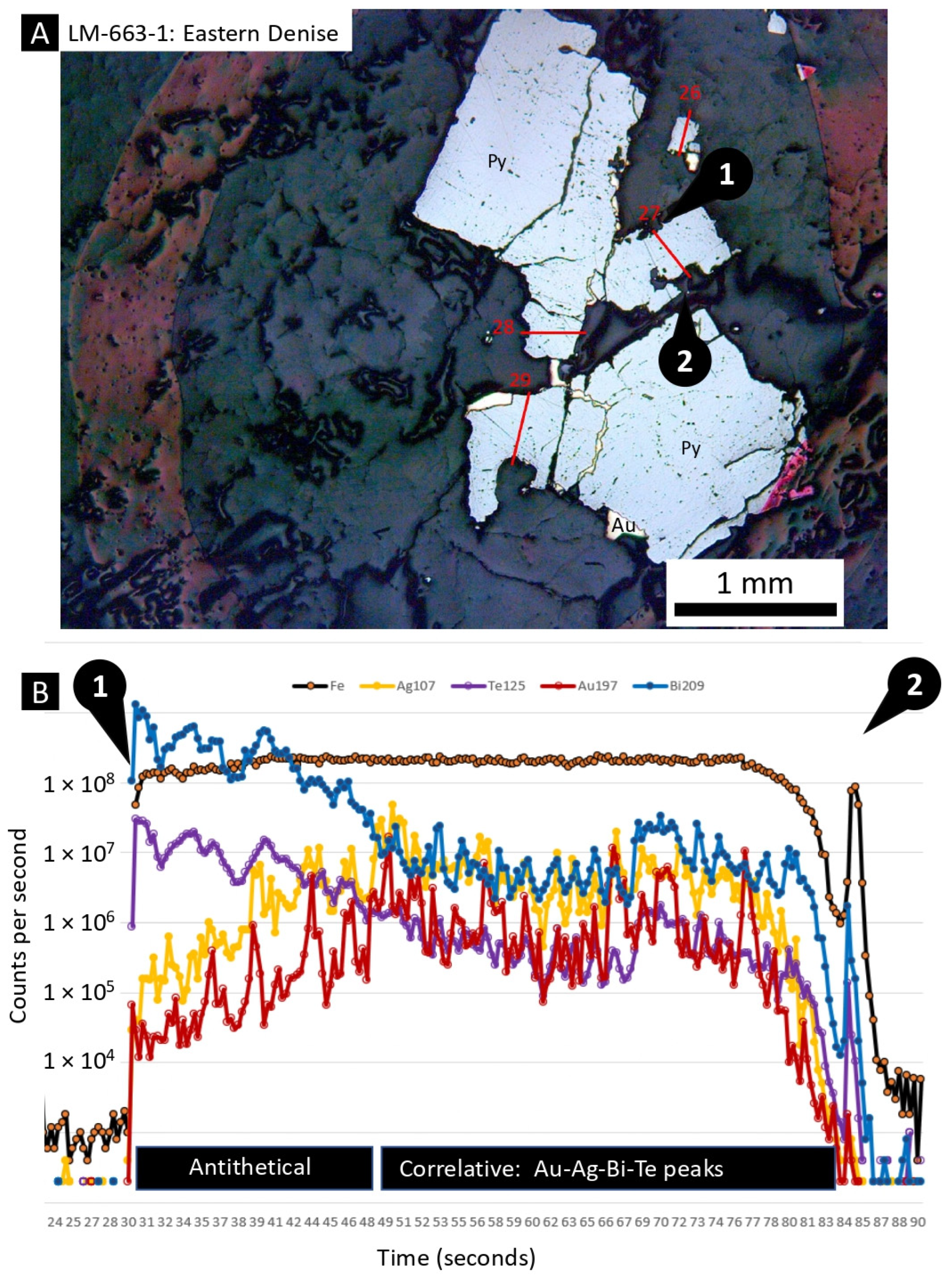
| Zone | Origin | T °C | Tl | Sn | W | In-Cd-Zn | Bi-Te-Au | Background | Sp | Po | Cpy | New Origin |
|---|---|---|---|---|---|---|---|---|---|---|---|---|
| QF | Volcanogenic | X | Volc | Volc | Volc | Volc | ||||||
| CPZ | Volcanogenic | 382 | X | Volc | Volc | Volc | Volc | |||||
| Donna | Volcanogenic | X | Volc | Volc | ||||||||
| Grey Cat | Orogenic | 361 | X | Orog | Orog | Volc | Orog- dominated | |||||
| HGZ | Orogenic | 364 | X | X | Orog | Orog | Orog | Orog | ||||
| E2 | Orogenic | X | X | Orog | Orog- dominated | |||||||
| Gratien | Orogenic | 348 | X | Orog | Orog | Orog | ||||||
| N110 | Orogenic | 369 | X | Different system | ||||||||
| Team | Hybrid | X | X | X | X | X | Orog | Orog | Orog | Orog- dominated | ||
| 210 | Hybrid | 385 | X | X | X | Different system | ||||||
| Upper HGZ | Hydrid | 389 | X | X | Orog | Orog | Orog | Orog- dominated | ||||
| Eastern Denise | Hydrid | 373 | X | X | Orog | Orog | Orog | Orog- dominated | ||||
| Denise | hybrid | 398 | X | Volc | Volc | Volc | Volc- dominated |
Disclaimer/Publisher’s Note: The statements, opinions and data contained in all publications are solely those of the individual author(s) and contributor(s) and not of MDPI and/or the editor(s). MDPI and/or the editor(s) disclaim responsibility for any injury to people or property resulting from any ideas, methods, instructions or products referred to in the content. |
© 2024 by the authors. Licensee MDPI, Basel, Switzerland. This article is an open access article distributed under the terms and conditions of the Creative Commons Attribution (CC BY) license (https://creativecommons.org/licenses/by/4.0/).
Share and Cite
Gaboury, D.; Genna, D.; Augustin, J.; Bouchard, M.; Trottier, J. LA-ICP-MS Analyses of Sulfides from Gold-Bearing Zones at the Perron Deposit, Abitibi Belt, Canada: Implications for Gold Remobilization through Metamorphism from Volcanogenic Mineralizations to Orogenic Quartz–Carbonate Veins. Minerals 2024, 14, 843. https://doi.org/10.3390/min14080843
Gaboury D, Genna D, Augustin J, Bouchard M, Trottier J. LA-ICP-MS Analyses of Sulfides from Gold-Bearing Zones at the Perron Deposit, Abitibi Belt, Canada: Implications for Gold Remobilization through Metamorphism from Volcanogenic Mineralizations to Orogenic Quartz–Carbonate Veins. Minerals. 2024; 14(8):843. https://doi.org/10.3390/min14080843
Chicago/Turabian StyleGaboury, Damien, Dominique Genna, Jérôme Augustin, Maxime Bouchard, and Jacques Trottier. 2024. "LA-ICP-MS Analyses of Sulfides from Gold-Bearing Zones at the Perron Deposit, Abitibi Belt, Canada: Implications for Gold Remobilization through Metamorphism from Volcanogenic Mineralizations to Orogenic Quartz–Carbonate Veins" Minerals 14, no. 8: 843. https://doi.org/10.3390/min14080843





